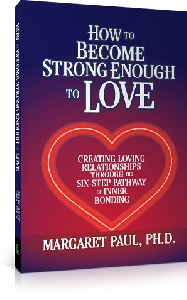The Wounded Self As Ally, Part II
By Karen Kral, M.A., LPCCJuly 15, 2009
Do you think of your Wounded Self as your enemy? Then read this article to learn eight ways to help your Wounded Self become a friend and ally on your journey toward healing and self-transformation.
The Wounded Self as Ally, Part II
By Karen Kral, M.A., LPCC
In Part I of The Wounded Self as Ally, I wrote about how we can engage in a relationship with our Wounded Self in a way that allows room for the Wounded Self to change, grow and get "on board" for healing. Among other things, this activity involves acknowledgment and respect for the Wounded Self along with willingness to use our imagination to cultivate a friendship or bond with the Wounded Self. In this article, I offer eight creative ways to engage the Wounded Self in the process of healing and transformation. If you have not yet read Part I of The Wounded Self as Ally, you may go to https://www.innerbonding.com/show-article/2164/the-wounded-self-as-ally.html, to do so.
8 Ways to Work With Rather Than Against Your Wounded Self
The first seven suggestions I recommend for learning to work with your Wounded Self will help you to build up to recommendation number eight, the Rite of Passage, which is designed to be offered to the growing aspect of your Wounded Self only after you have forged a bond with this part of you and you feel he is truly ready to "drop" his shield of protection-which means that he will no longer be identified with your Wounded Self, but will be transformed into a helper on your journey toward self love and happiness.
Although the first seven suggestions for working with your Wounded Self do not need to be worked in any specific order, other than waiting for the appropriate time to move to a Rite of Passage, it is helpful to begin building your relationship with your Wounded Self by first deeply feeling, understanding, processing and expressing suggestion number one:
1) Honor your Wounded Self for the Ways he Helped you Survive
- Write down all the things your Wounded Self did for you that helped you survive.
- Talk with your Wounded Self about her "very good reasons" for protecting and controlling in the ways she does. Be curious about her reasons.
- Next, ask your Wounded Self when she first learned how to protect in this way. This will help you, the Loving Adult, to move out of shame, blame and self-judgment and into understanding and compassion about your unhealthy behaviors.
- Verbally acknowledge your Wounded Self for using these strategies at a time when there was no adult around to teach you healthier strategies.
- Cry, grieve and do an anger process with your Wounded Self as you both realize that there was truly nothing you could have done to change the situation where the strategy was initially employed.
The next two methods for working with your Wounded Self are Rapport Builders. Rapport builders build a bridge between you and your Wounded Self through the use of playfulness and fun.
2) Give your Wounded Self a Dare
- "I DARE you to come with me and listen to what my Guidance says. You can even hide behind me if you want."
- "I DARE you to do something different with me in this situation. Let's try it and see what happens, okay?"
- "I DARE you to sit with me in this sadness and not eat that whole pizza."
3) Joke and Banter with your Wounded Self
- Wounded Self says, "I'm not afraid of anything!" Loving Adult banters back, "Yes, I know. But, what about those feelings?!"
- Wounded Self says, "Oh poor me...." Loving Adult laughs (only from a positive intention-because otherwise the WS will feel criticized), and makes a Winnie the Pooh reference, "Oh bother!"
Once some playful bantering has occurred, you may have created some rapport with your Wounded Self to begin a conversation about real healing.
The next two methods for engaging with your Wounded Self are Safety Builders. Safety Builders offer ways for your Wounded Self to feel safe by empowering her to create it for herself, rather than having to create it through you.
4) Let your Wounded Self Have his Very Own Spiritual Guidance
Yes, you heard me. Would you like to let your Wounded Self feel like he is still important, that you sense some "health" in him? Then, trust him enough to let him pick a spiritual guide that is totally his own. You may choose God. He might choose Raven or Mad Maxx.
Give your Wounded Self the same guidelines you use when working with guidance: If it feels peaceful and loving, it is guidance; if it feels like crap, it's not! You can banter and play with your Wounded Self if he tries to "take in" guidance from an "untrue" source. But, you may be amazed how a Wounded Self on the verge of change may be willing to open up to profound spiritual guidance that can assist both of you.
5) Give your Wounded Self the Option of "Throwing Away" what Guidance Says if She Doesn't Like It.
Whether your Wounded Self joins you in listening to your guidance or chooses her own, on the first try, you may wish to offer your Wounded Self a "way out" if she is afraid. When she feels like she has a way out, you may find that she is much more receptive to actually listening to and taking in what guidance says. When truthful guidance actually comes in and your Wounded Self is having trouble accepting it, you can return to rapport building exercises such as joking about how her last strategy got you both into so much trouble or daring him to try what his new guidance suggested.
Suggestions six and seven are Healthy Logic Builders. Healthy Logic Builders help to stimulate the intellect of your Wounded Self and offer ways to negotiate new behaviors, with your Wounded Self on board for change.
6) The "Are you Tired" Question
Ask your Wounded Self about all the ways she has protected you. Ask her to explain them in detail. Make comments along the way such as, "Wow. That seems like a lot of work!" Next, ask if this work is at all tiring for her. Ask her if she enjoys the work. Ask if she wishes there was someone else who was smart enough and strong enough to do her very important job. With your help, you can lead your Wounded Self toward a path of self discovery about just how very exhausted she is from protecting.
7) What Dreams May Come?
Ask your Wounded Self what his dreams were before he ever had to start protecting. Even though at first, your Wounded Self may believe that his dreams will never come true, you can begin to talk to him about what is possible when he moves from protecting and controlling to dreaming.
And, finally,
8) Take your Wounded Self Through a Rite of Passage
A rite of passage is a way for your Wounded Self to voluntarily take on a new role in your internal system, once she has begun to understand that the life circumstances that caused her to initially protect have changed. A rite of passage often involves a challenge to the individual that she must successfully complete, followed by a ceremony and a proclamation of "passage" from one state or role to another. You may have heard, for example, of the tradition in many native cultures of young men being sent to spend an evening alone in a cave to face their fear, and thereby receive "passage" into manhood. Rites of passage are not part of our western tradition or upbringing, and yet, I find that they provide a powerful vehicle for the development of the Wounded Self beyond its conditioned strategies of protection and control.
A rite of passage is an honor for the Wounded Self and should be thoroughly thought out by the Loving Adult as well as by the Wounded Self, who should be involved in the process. You and your Wounded Self may enjoy using ceremonial supplies such as sage, bones, music, handmade gifts, and some sort of emblem or attire that signifies the transition from "old role" to new. If your Wounded Self, for example, is hyper-vigilant as a result of trauma she endured as a child, she may wish to "be tested" by a series of live interactions with others to determine, using her emotions and body sensations, whether the situation is safe or unsafe. After successfully passing the test, she may wish to have a ceremony in the mountains, next to a Native American Medicine Wheel, or near a symbol of her own making-a rock pile of "letting go" of old hurts, a list of "false beliefs" she wants to burn and release, or a painting of the "true self" that she wants to claim. Once the ceremony is completed, your Loving Adult may symbolize the transition by crowning this formerly hyper-vigilant Wounded Self the "Seeker of Happiness" or by providing her with a "cloak" of protection (from Spirit) so that she may now freely engage in a new role, such as that of seeking out positive experiences rather than tensing her body in anticipation of bad ones.
There are many ways we can begin to open to the healthy aspects of our Wounded Self and to develop a relationship with that part of us. What I have shared here are just a few examples that have come from my work with my own Wounded Self or from similar work my clients have done. I trust that as you open to a deeper friendship with your Wounded Self, you will create your own unique style of communicating with him or her and allow this part of you to become your ally on your journey toward self-healing. Remember, we will always have a Wounded Self. We will always have a part of us that, when afraid, wants to control and protect in the face of fear. And, yet, even the Wounded Self has layers, facets, and aspects. Is one part of your Wounded Self ready to get on board with healing? It may serve you to find out.
This article was written by Karen Kral, M.A. LPCC. Karen is licensed psychotherapist in New Mexico and Colorado (LPC) and is a certified facilitator of Inner Bonding. She offers intensives in the Santa Fe, New Mexico area. You may view her biography under "Facilitators" and visit her website at http://www.corequestpotential.com/
 Send this article to a friend
Send this article to a friend  Print this article
Print this article  Bookmarked 12 time(s)
Bookmarked 12 time(s)
| Related Articles |
|---|
| Learning Compassion for Myself |
| Love and the Wounded Self |
| Our Wounded Parts are Not Wrong: Learning to Love Ourselves |
| The Wounded Self as Ally |
Comments
| Author | Comment | Date |
|---|---|---|
| Join the Inner Bonding Community to add your comment to articles and see the comments of others... | ||

Daily Inspiration
The challenge on the spiritual path is to reach such a deep place of inner security that we are able to stay open to learning with ourselves and with Spirit, no matter what. This means being able to be loving to ourselves in the face of others attacking, blaming, crazymaking, withdrawing. It means staying open to learning with Spiritregarding our own highest good and the highest good of all, no matter what.
By Dr. Margaret Paul

 Share with Del.icio.us
Share with Del.icio.us Share with Digg
Share with Digg






